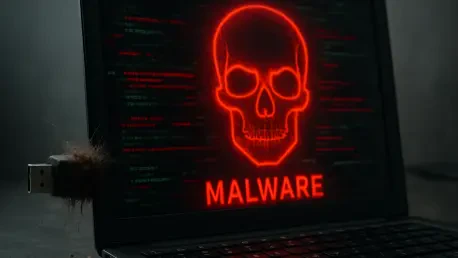Setting the Stage: The Alarming Scale of Cybercrime Facilitation
In the shadowy depths of the digital world, a staggering statistic emerges: cybercrime is projected to cost global economies $10.5 trillion annually by the end of this year, according to industry estimates. At the heart of this escalating threat lies SocGholish malware, also known as FakeUpdates, a JavaScript loader that has become a cornerstone for cybercriminal operations worldwide. Orchestrated by the threat actor TA569, this malware serves as a critical enabler, powering access for notorious groups like LockBit and Evil Corp. This market analysis delves into the intricate ecosystem fueled by SocGholish, examining its distribution mechanisms, its pivotal role in the Malware-as-a-Service (MaaS) model, and the broader trends shaping the cybercrime landscape. By unpacking current patterns and projecting future trajectories, the goal is to illuminate the strategic implications for cybersecurity stakeholders and highlight actionable pathways to mitigate this pervasive threat.
Dissecting the Market: Trends and Mechanisms Driving SocGholish
Distribution Tactics: Exploiting Trust as a Market Entry Point
SocGholish has carved a niche in the cybercrime market through its cunning use of deceptive distribution strategies, primarily via fake software updates. Mimicking legitimate prompts for popular tools like Mozilla Firefox or Microsoft Teams, it lures users into downloading malicious payloads from compromised websites. These sites are often infiltrated through direct script injections, creating a seamless facade of legitimacy. Traffic Distribution Systems (TDSs) such as Parrot TDS and Keitaro TDS further refine this approach by profiling users and redirecting only suitable targets to malicious content, enhancing infection efficiency. This targeted delivery not only maximizes market penetration but also poses a significant challenge for defenders, as distinguishing malicious updates from genuine ones remains a persistent hurdle in user behavior.
Positioning as an Access Broker: Fueling a Collaborative Crime Economy
A defining feature of SocGholish’s market impact is its role as an initial access broker within the MaaS framework. Once a system is compromised, access is sold to high-profile cybercriminal entities, including LockBit, Evil Corp, and Dridex, creating a lucrative supply chain for downstream attacks like ransomware. Recent data indicates a complex interplay with other malware, such as Raspberry Robin, which serves both as a distribution vector and a secondary payload in certain campaigns. This reciprocity suggests a deeply interconnected market where operators may share tactics or resources, amplifying the scale and impact of attacks. For cybersecurity firms, this collaborative economy underscores the need to target key nodes, though the adaptability of these networks complicates disruption efforts.
Evasion Innovation: Adapting to Defensive Market Shifts
The cybercrime market is characterized by rapid innovation, and SocGholish exemplifies this through evolving evasion tactics. Associated threats like Raspberry Robin have integrated advanced obfuscation and shifted to ChaCha20 encryption, alongside exploiting new vulnerabilities for privilege escalation. Similarly, trends in related malware show a pivot toward phishing-based delivery and sophisticated obfuscation tools, reflecting a market-wide push to bypass detection mechanisms. SocGholish itself employs dynamic payload generation and victim monitoring within its command-and-control infrastructure, halting delivery if suspicion arises. These adaptations highlight a competitive market where threat actors continuously refine their offerings to counter defensive technologies, posing ongoing challenges for security providers striving to keep pace.
Market Projections: The Future Trajectory of SocGholish-Driven Threats
Rising Sophistication in Target Selection and Delivery
Looking ahead, the reliance on TDSs for traffic manipulation signals a trend toward greater sophistication in target selection within the cybercrime market. Automation and machine learning are likely to play larger roles, enabling more precise profiling and delivery of malicious payloads over the next few years, from 2025 to 2027. This technological advancement could further entrench SocGholish as a dominant player, enhancing its ability to filter and exploit high-value targets. For businesses, this projection indicates a pressing need to invest in advanced behavioral analytics to detect anomalous traffic patterns before infections take hold, as traditional signature-based defenses become increasingly obsolete.
Deepening Collaboration in the Malware-as-a-Service Model
Another critical forecast is the continued growth of the MaaS model, with SocGholish positioned as vital infrastructure for ransomware and data theft operations. The deepening ties among cybercrime groups, evidenced by overlapping campaigns and potential shared personnel with entities like Dridex, point to a more organized and collaborative market structure. This trend suggests that isolated defensive measures may fall short, as threat actors pool resources to maximize impact. Industry stakeholders must anticipate a market where access brokers like SocGholish drive an escalating volume of secondary attacks, necessitating broader intelligence-sharing initiatives to map and disrupt these interconnected networks.
Regulatory and Technological Arms Race
Finally, the market outlook reveals an impending arms race between cybercriminals and regulatory bodies. Efforts to curb malvertising and TDS misuse are expected to intensify, yet enforcement will likely struggle to match the pace of threat innovation. Technological shifts, such as the adoption of new encryption standards and local exploits, indicate that threat actors will maintain a competitive edge in evading detection. This dynamic suggests a market where cybersecurity solutions must evolve toward proactive, adaptive frameworks rather than reactive fixes. For policymakers, the challenge lies in balancing legitimate uses of tools like Keitaro TDS with security imperatives, a gray area that will shape market responses in the coming years.
Reflecting on the Analysis: Strategic Insights for Stakeholders
Looking back on this market analysis, it becomes evident that SocGholish malware has entrenched itself as a linchpin in the cybercrime economy, leveraging deceptive distribution, strategic partnerships, and relentless innovation to amplify its impact. The trends of sophisticated target selection, collaborative MaaS frameworks, and an ongoing technological arms race paint a sobering picture of the challenges faced by cybersecurity defenders. For stakeholders, the path forward involves prioritizing user education to combat fake update scams, alongside deploying robust endpoint detection solutions to catch early-stage compromises. Collaborative threat intelligence platforms emerge as a vital tool to dismantle interconnected networks, while investment in adaptive technologies offers a counter to evolving evasion tactics. Ultimately, the battle against SocGholish and its ecosystem demands a unified, forward-thinking approach to safeguard digital markets from this pervasive threat.









